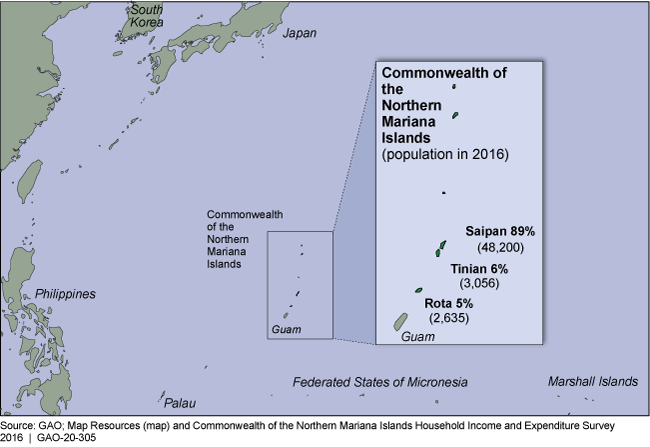Commonwealth of the Northern Mariana Islands: Recent Economic and Workforce Trends
Fast Facts
The Commonwealth of the Northern Mariana Islands is a U.S territory in the Pacific. It has been exempt from some U.S. immigration and other laws, but is transitioning to the U.S. immigration system. We reviewed trends in its workforce and economy.
The ratio of U.S. to foreign workers remained around 50% from 2014-2018
GDP increased about 28% in 2016 and 26% in 2017, which coincided with the opening of a casino
However, the economy contracted 20% after a devastating 2018 typhoon
The casino has been cited by several federal agencies for unfair labor practices, and its financial reporting raises questions about its viability
The Commonwealth of the Northern Mariana Islands

map
Highlights
What GAO Found
Although the Commonwealth of the Northern Mariana Islands (CNMI) economy grew in 2016 and 2017, it declined in 2018. The U.S. Department of Commerce's Bureau of Economic Analysis (BEA) reports that the CNMI's gross domestic product (GDP) grew 28.4 percent in 2016 and 25.5 percent in 2017, which reflected continued growth in visitor spending, particularly for casino gambling. However, BEA estimates that GDP in the CNMI fell by 20 percent in 2018, with a sharp drop in tourist spending and casino gambling revenues following the severe damage of Super Typhoon Yutu, which made landfall in October 2018. According to BEA, revenue from casino gambling dropped over 50 percent in 2018. In August 2019, the parent company of the casino in the CNMI warned shareholders and potential investors that it expected to record a loss for the first 6 months of 2019 as compared with a profit for the same period in 2018. The company's independent auditor also concluded that the financial information for the first 6 months of 2019 might cast significant doubt on the ability of the company to continue as a going concern.
The ratio of United States workers to foreign workers in the CNMI remained close to 50 percent from 2014 through 2018, with United States workers making up 49 percent of the workforce in 2018, according to CNMI tax data. The size of the workforce grew each year from 2014 through 2017, before contracting by almost 2,000 workers in 2018. For 2018, the Department of Homeland Security approved about 9,000 CW-1 foreign worker permits, and approved more than 11,000 permits for 2019.
Employed Workers in the Commonwealth of the Northern Mariana Islands (CNMI), Calendar Years 2001-2018

Note: United States workers include U.S. citizens and nationals and citizens of the Freely Associated States—the Federated States of Micronesia, the Republic of the Marshall Islands, and the Republic of Palau, as reported by CNMI employers on employee W-2 forms. Foreign workers include all other workers. Current available data does not allow for the identification of all persons lawfully admitted for permanent residence. The CNMI government first collected information on persons lawfully admitted for permanent residence in 2018, but the data were incomplete.
Why GAO Did This Study
The Consolidated Natural Resources Act of 2008, which amended the 1976 covenant between the United States and the CNMI, established federal control of CNMI immigration beginning in 2009. Under the act, the Department of Homeland Security began implementing a foreign worker permit program that was specific to the CNMI. The Northern Mariana Islands U.S. Workforce Act of 2018 extended the CNMI-Only Transitional Worker (CW-1) program for 10 additional years, through the end of 2029.
The Northern Mariana Islands U.S. Workforce Act of 2018 included a provision for GAO to examine the ratio of United States workers to other workers over the 5 previous calendar years in the CNMI. This report examines (1) recent economic trends in the CNMI through 2018, and (2) recent trends in the composition of the CNMI workforce from 2001 through 2018, including the ratio of United States workers to foreign workers for each of the 5 previous calendar years. GAO analyzed CNMI government and U.S. agency data, prior GAO reports, and interviewed officials from the CNMI government, and the U.S. Departments of Commerce, Homeland Security, the Interior, and Labor.
For more information, contact David B. Gootnick at (202) 512-3149 or gootnickd@gao.gov.
